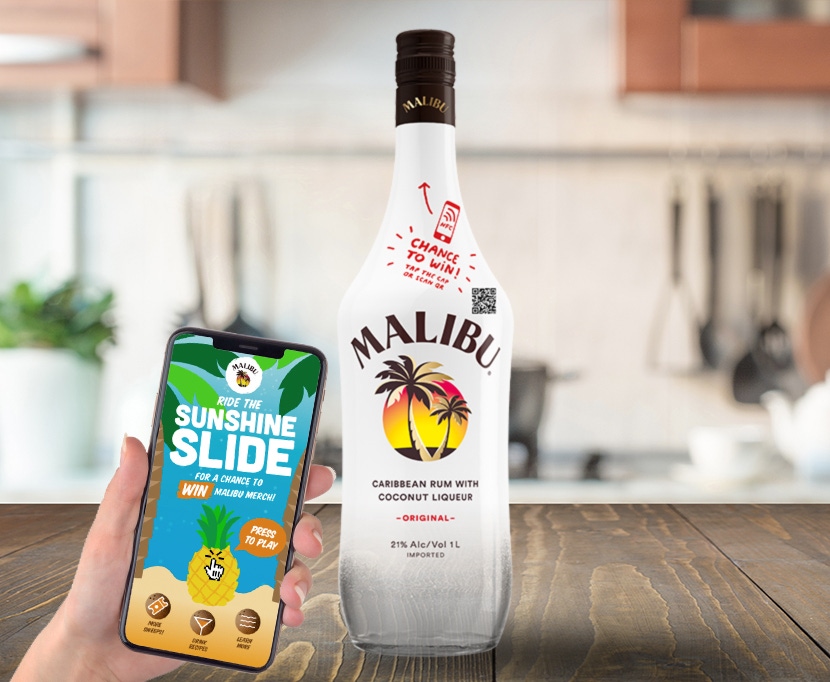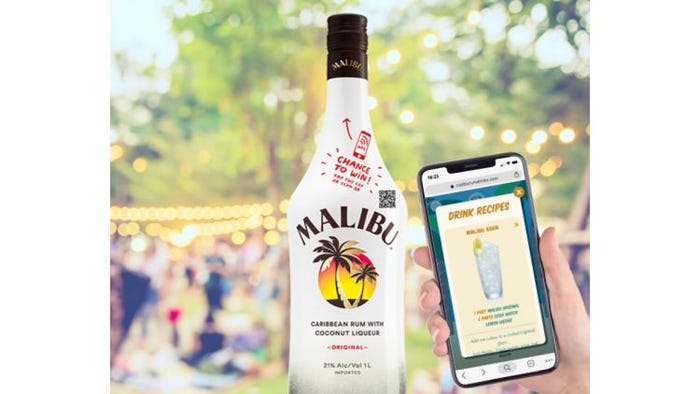On-pack QR code and NFC plug rum drinkers into Malibu brand

The Absolut Co., owner of the Malibu rum brand, is using smart packaging to create a closer connection with consumers. The company recently announced the launch of 300,000 “connected” Malibu bottles in the United States.
This limited-edition packaging design features dual smart-packaging technologies: a near-field communication (NFC) technologyin the closure as well as a quick response (QR) codeon the bottle’s front shoulder.
Consumers tap the closure with their phone or scan the QR code to participate in a summertime promotion called Malibu Gamesvia the Sunshine Slide mobile game, which offers prizes of Malibu merchandise.The NFC closure and QR code also provide access to drink recipes and sweepstakes competitions. The front of the bottle is printed with concise directions on how to use the smart features.
This year’s Malibu Games started in May and will conclude in early September. Malibu’s connected bottles will be distributed in Ohio and Texas, where they will be sold while supplies last.
Caitriona Murphy, Malibu global brand manager, answers Packaging Digest’s questions about the package and its smart features and benefits.
Why is the Malibu brand using both NFC and QR technologies on the same bottle?
Murphy: Our goal with connected-bottle experimentation is to find the right technology to ensure an added value and seamless consumer experience. NFC is gaining great momentum and becoming more prevalent as a technology. But in certain markets, QR is still much more familiar for our consumers to recognize and understand.

Simple label instructions explain how Malibu customers can access valuable extras by either tapping the closure or scanning the QR code.
Additionally, certain models of phone do not have a seamless interaction with NFC, and we want to avoid requiring consumers to download an app in order to interact.
For this year’s launch, we provided both technologies as access points, allowing us to test awareness and popularity of the two and to allow the maximum number of consumers to have a good connection experience.
Which technology do you see as ultimately coming out as the pervasive smart technology for packaging, either at Absolut or in the industry as a whole?
Murphy: We see a huge potential with NFC to provide both intuitive and personalized consumer experiences and the opportunity for brands to open up dialogue directly with those consumers, generating valuable insights into shopper behavior and recruiting to the brand.
If brands can successfully leverage the technology and educate consumers on the “tap” behavior, and the NFC industry can work to deliver cost-effective tags, there is certainly a huge potential for it to become the preferred method for creating smart-packaging experiences.
How do NFC and QR compare on cost, within the context of packaging applications?
Murphy: From a pure technology standpoint, NFC tags are currently more expensive to work with when compared with QR codes. However, it is important to consider not just the upfront costs but the value created by the campaign. If one technology gets a much higher engagement rate over the other or allows for a consumer experience that recruits more valuable consumer leads, then these are all extremely important considerations when weighing the costs and benefit.
What recommendations would you give other consumer-goods companies that are interested in “connecting” their package?
Murphy: To benefit and create value from the activation, there needs to be a clear consumer value exchange and reason for consumers to engage. The most successful connected packaging initiatives have been based on a clear creative idea that is immediately understood and appreciated by consumers—brands cannot repeat the mistakes of the past by linking to low-quality content that is not relevant and offers no added benefit.
What type of closure is used on Malibu’s smart bottle?
Murphy: The new Malibu connected bottles are equipped with a world-leading design that showcases an aluminum bottle cap integrating NFC technology.
Can you mention any of the packaging or technology suppliers you worked with in the development of this package?
Murphy: Malibu worked with Virtue (the creative agency by Vice Media) and Guala Closures Group, in association with Avery Dennison, during the development of its connected bottles.
About the Author(s)
You May Also Like




